Marketing and Communication Report: Marks & Spencer's Strategies
VerifiedAdded on 2023/04/20
|12
|3287
|56
Report
AI Summary
This report provides a comprehensive analysis of the marketing strategies employed by Marks & Spencer (M&S). It begins with an introduction outlining the brand's evolution from its origins to its current international presence. The report delves into the concepts of needs, wants, and demands, explaining how M&S has leveraged these to its advantage. A situational analysis is conducted, including a SWOT analysis, to assess the brand's strengths, weaknesses, opportunities, and threats. The competitive environment, including key competitors like Tesco and Sainsbury's, is examined. Internal environmental factors, such as physical and human resources, are also considered. The marketing mix, encompassing product, price, place, and promotion strategies, is thoroughly discussed. The report concludes by summarizing M&S's position as a leading retailer in the UK, highlighting its market segmentation and international expansion efforts. The report also includes an overview of a separate communication campaign review, outlining the DRIP marketing theory, target audience, promotional mix, key messages, and effectiveness measurement methods.
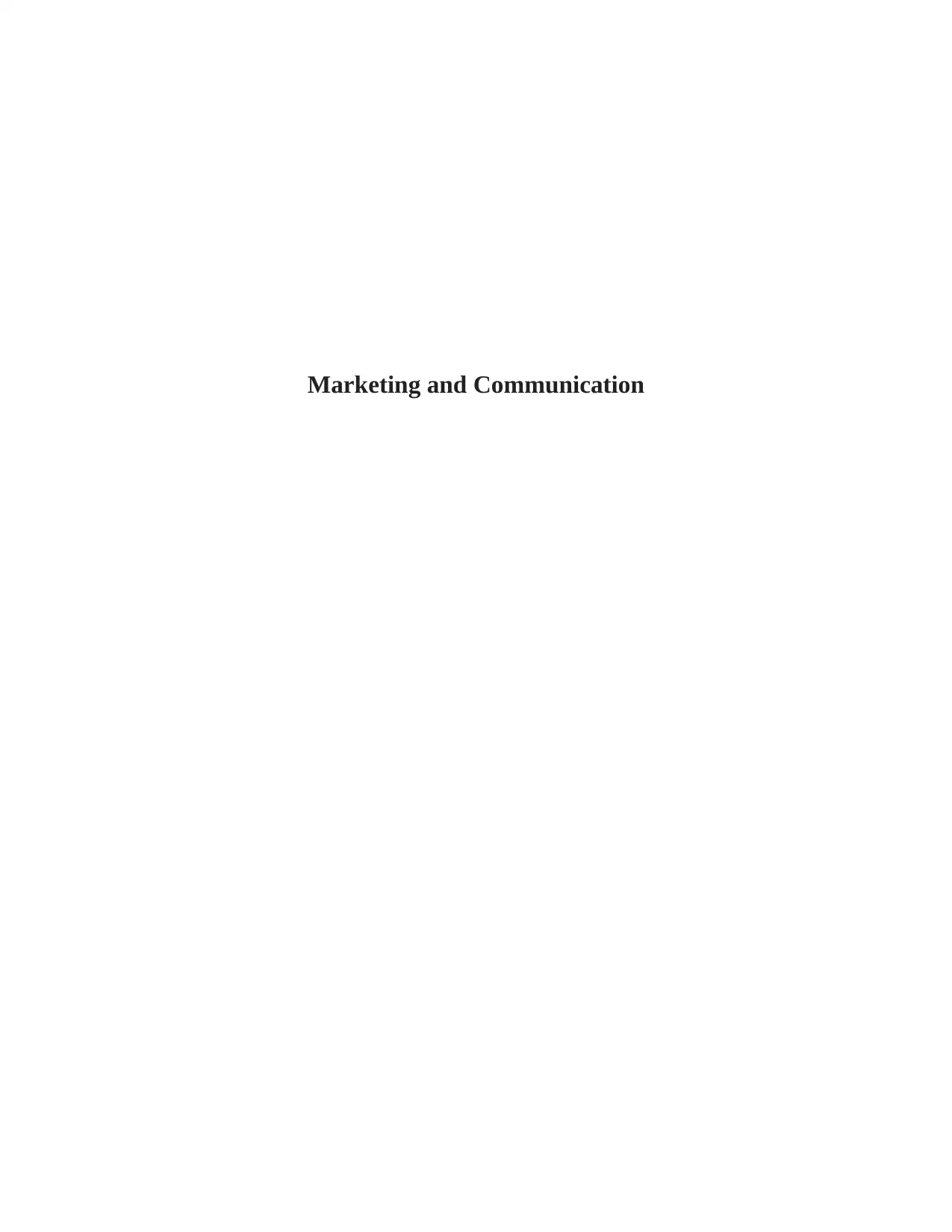
Marketing and Communication
Paraphrase This Document
Need a fresh take? Get an instant paraphrase of this document with our AI Paraphraser
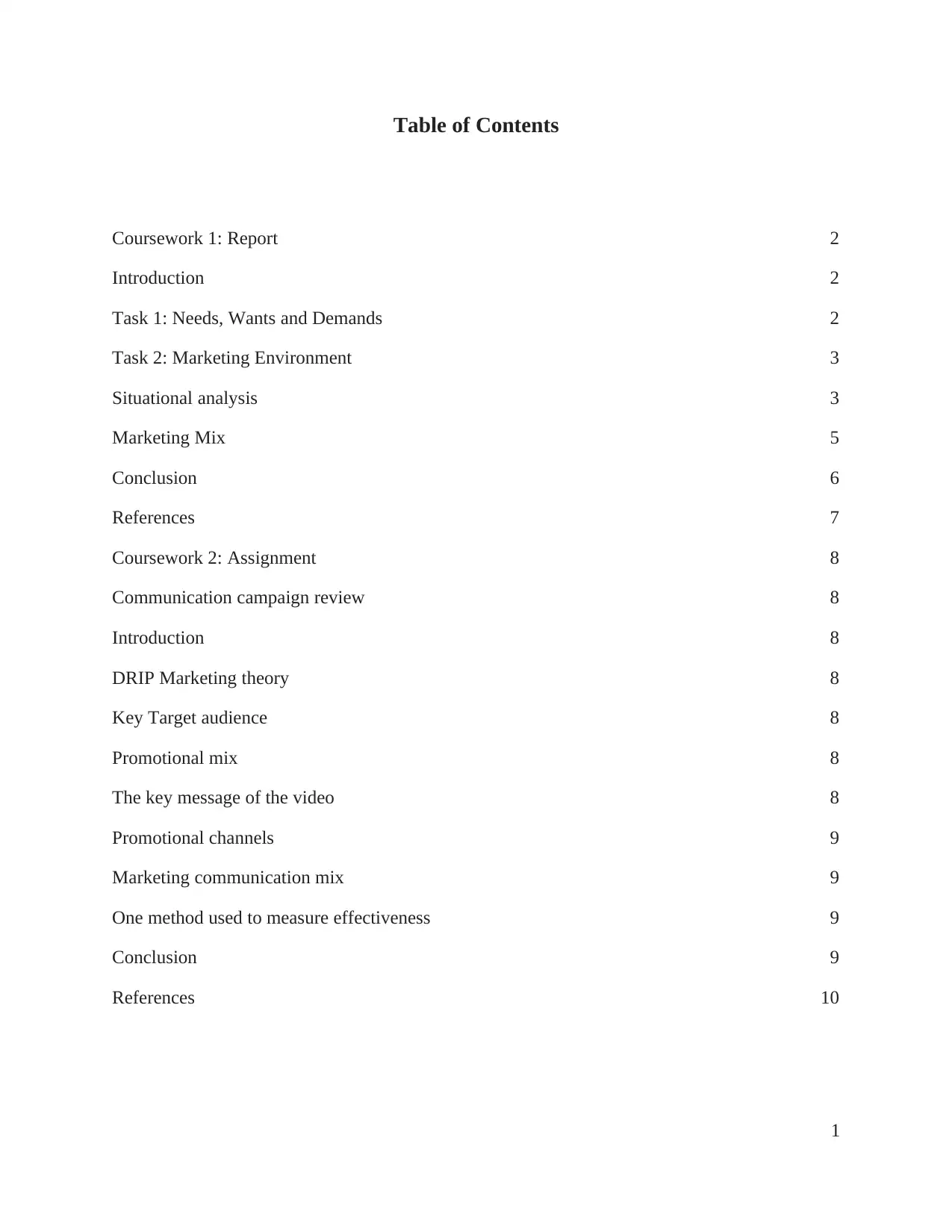
Table of Contents
Coursework 1: Report 2
Introduction 2
Task 1: Needs, Wants and Demands 2
Task 2: Marketing Environment 3
Situational analysis 3
Marketing Mix 5
Conclusion 6
References 7
Coursework 2: Assignment 8
Communication campaign review 8
Introduction 8
DRIP Marketing theory 8
Key Target audience 8
Promotional mix 8
The key message of the video 8
Promotional channels 9
Marketing communication mix 9
One method used to measure effectiveness 9
Conclusion 9
References 10
1
Coursework 1: Report 2
Introduction 2
Task 1: Needs, Wants and Demands 2
Task 2: Marketing Environment 3
Situational analysis 3
Marketing Mix 5
Conclusion 6
References 7
Coursework 2: Assignment 8
Communication campaign review 8
Introduction 8
DRIP Marketing theory 8
Key Target audience 8
Promotional mix 8
The key message of the video 8
Promotional channels 9
Marketing communication mix 9
One method used to measure effectiveness 9
Conclusion 9
References 10
1
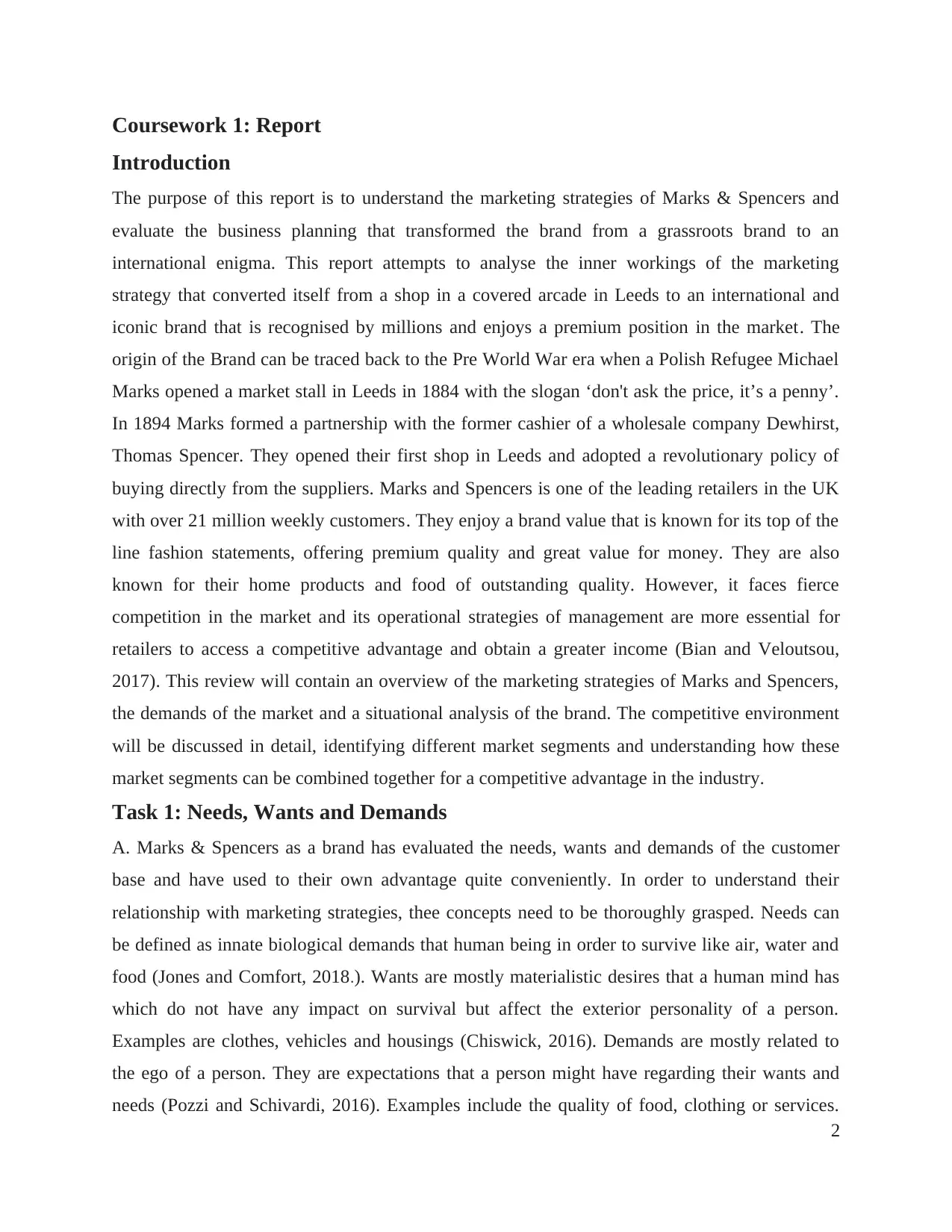
Coursework 1: Report
Introduction
The purpose of this report is to understand the marketing strategies of Marks & Spencers and
evaluate the business planning that transformed the brand from a grassroots brand to an
international enigma. This report attempts to analyse the inner workings of the marketing
strategy that converted itself from a shop in a covered arcade in Leeds to an international and
iconic brand that is recognised by millions and enjoys a premium position in the market. The
origin of the Brand can be traced back to the Pre World War era when a Polish Refugee Michael
Marks opened a market stall in Leeds in 1884 with the slogan ‘don't ask the price, it’s a penny’.
In 1894 Marks formed a partnership with the former cashier of a wholesale company Dewhirst,
Thomas Spencer. They opened their first shop in Leeds and adopted a revolutionary policy of
buying directly from the suppliers. Marks and Spencers is one of the leading retailers in the UK
with over 21 million weekly customers. They enjoy a brand value that is known for its top of the
line fashion statements, offering premium quality and great value for money. They are also
known for their home products and food of outstanding quality. However, it faces fierce
competition in the market and its operational strategies of management are more essential for
retailers to access a competitive advantage and obtain a greater income (Bian and Veloutsou,
2017). This review will contain an overview of the marketing strategies of Marks and Spencers,
the demands of the market and a situational analysis of the brand. The competitive environment
will be discussed in detail, identifying different market segments and understanding how these
market segments can be combined together for a competitive advantage in the industry.
Task 1: Needs, Wants and Demands
A. Marks & Spencers as a brand has evaluated the needs, wants and demands of the customer
base and have used to their own advantage quite conveniently. In order to understand their
relationship with marketing strategies, thee concepts need to be thoroughly grasped. Needs can
be defined as innate biological demands that human being in order to survive like air, water and
food (Jones and Comfort, 2018.). Wants are mostly materialistic desires that a human mind has
which do not have any impact on survival but affect the exterior personality of a person.
Examples are clothes, vehicles and housings (Chiswick, 2016). Demands are mostly related to
the ego of a person. They are expectations that a person might have regarding their wants and
needs (Pozzi and Schivardi, 2016). Examples include the quality of food, clothing or services.
2
Introduction
The purpose of this report is to understand the marketing strategies of Marks & Spencers and
evaluate the business planning that transformed the brand from a grassroots brand to an
international enigma. This report attempts to analyse the inner workings of the marketing
strategy that converted itself from a shop in a covered arcade in Leeds to an international and
iconic brand that is recognised by millions and enjoys a premium position in the market. The
origin of the Brand can be traced back to the Pre World War era when a Polish Refugee Michael
Marks opened a market stall in Leeds in 1884 with the slogan ‘don't ask the price, it’s a penny’.
In 1894 Marks formed a partnership with the former cashier of a wholesale company Dewhirst,
Thomas Spencer. They opened their first shop in Leeds and adopted a revolutionary policy of
buying directly from the suppliers. Marks and Spencers is one of the leading retailers in the UK
with over 21 million weekly customers. They enjoy a brand value that is known for its top of the
line fashion statements, offering premium quality and great value for money. They are also
known for their home products and food of outstanding quality. However, it faces fierce
competition in the market and its operational strategies of management are more essential for
retailers to access a competitive advantage and obtain a greater income (Bian and Veloutsou,
2017). This review will contain an overview of the marketing strategies of Marks and Spencers,
the demands of the market and a situational analysis of the brand. The competitive environment
will be discussed in detail, identifying different market segments and understanding how these
market segments can be combined together for a competitive advantage in the industry.
Task 1: Needs, Wants and Demands
A. Marks & Spencers as a brand has evaluated the needs, wants and demands of the customer
base and have used to their own advantage quite conveniently. In order to understand their
relationship with marketing strategies, thee concepts need to be thoroughly grasped. Needs can
be defined as innate biological demands that human being in order to survive like air, water and
food (Jones and Comfort, 2018.). Wants are mostly materialistic desires that a human mind has
which do not have any impact on survival but affect the exterior personality of a person.
Examples are clothes, vehicles and housings (Chiswick, 2016). Demands are mostly related to
the ego of a person. They are expectations that a person might have regarding their wants and
needs (Pozzi and Schivardi, 2016). Examples include the quality of food, clothing or services.
2
⊘ This is a preview!⊘
Do you want full access?
Subscribe today to unlock all pages.

Trusted by 1+ million students worldwide
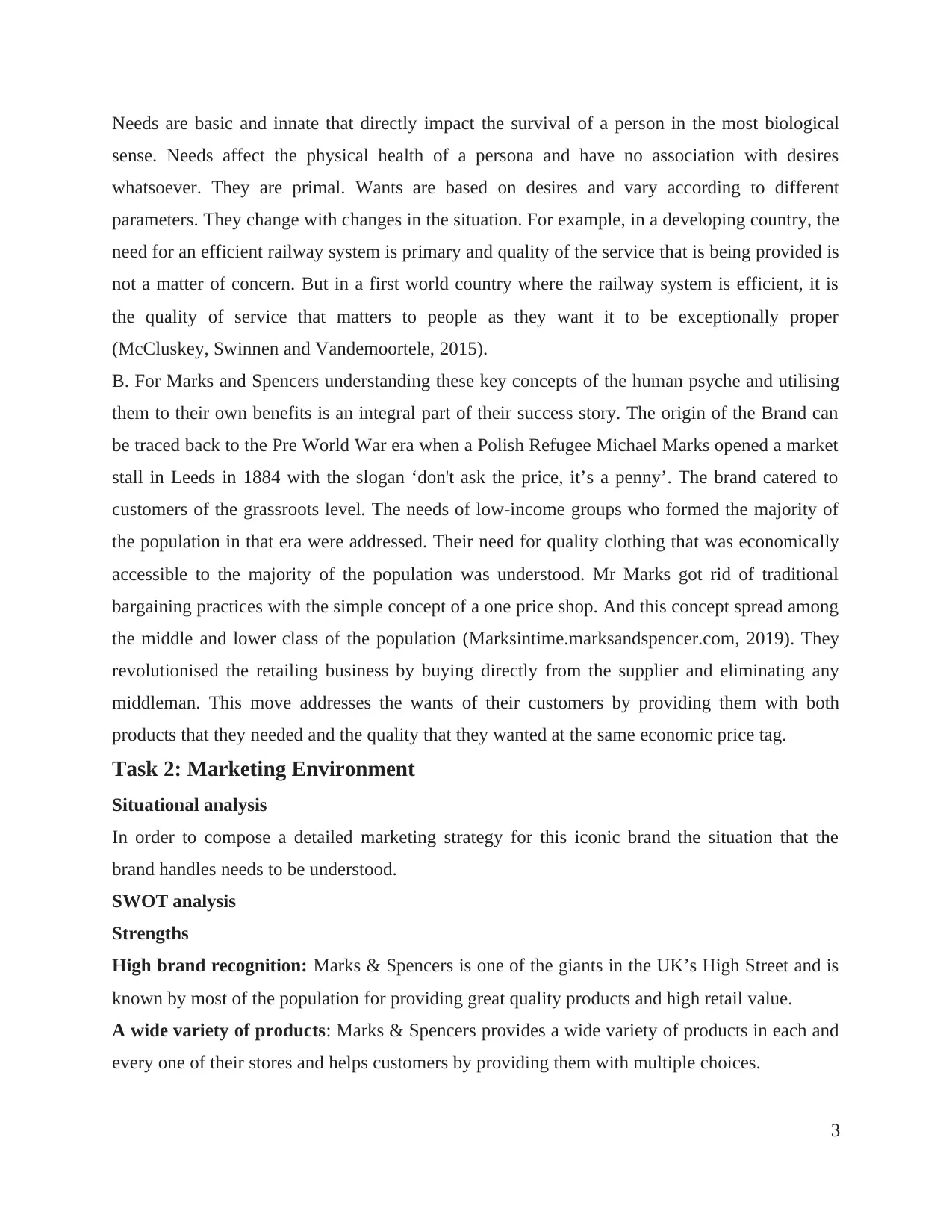
Needs are basic and innate that directly impact the survival of a person in the most biological
sense. Needs affect the physical health of a persona and have no association with desires
whatsoever. They are primal. Wants are based on desires and vary according to different
parameters. They change with changes in the situation. For example, in a developing country, the
need for an efficient railway system is primary and quality of the service that is being provided is
not a matter of concern. But in a first world country where the railway system is efficient, it is
the quality of service that matters to people as they want it to be exceptionally proper
(McCluskey, Swinnen and Vandemoortele, 2015).
B. For Marks and Spencers understanding these key concepts of the human psyche and utilising
them to their own benefits is an integral part of their success story. The origin of the Brand can
be traced back to the Pre World War era when a Polish Refugee Michael Marks opened a market
stall in Leeds in 1884 with the slogan ‘don't ask the price, it’s a penny’. The brand catered to
customers of the grassroots level. The needs of low-income groups who formed the majority of
the population in that era were addressed. Their need for quality clothing that was economically
accessible to the majority of the population was understood. Mr Marks got rid of traditional
bargaining practices with the simple concept of a one price shop. And this concept spread among
the middle and lower class of the population (Marksintime.marksandspencer.com, 2019). They
revolutionised the retailing business by buying directly from the supplier and eliminating any
middleman. This move addresses the wants of their customers by providing them with both
products that they needed and the quality that they wanted at the same economic price tag.
Task 2: Marketing Environment
Situational analysis
In order to compose a detailed marketing strategy for this iconic brand the situation that the
brand handles needs to be understood.
SWOT analysis
Strengths
High brand recognition: Marks & Spencers is one of the giants in the UK’s High Street and is
known by most of the population for providing great quality products and high retail value.
A wide variety of products: Marks & Spencers provides a wide variety of products in each and
every one of their stores and helps customers by providing them with multiple choices.
3
sense. Needs affect the physical health of a persona and have no association with desires
whatsoever. They are primal. Wants are based on desires and vary according to different
parameters. They change with changes in the situation. For example, in a developing country, the
need for an efficient railway system is primary and quality of the service that is being provided is
not a matter of concern. But in a first world country where the railway system is efficient, it is
the quality of service that matters to people as they want it to be exceptionally proper
(McCluskey, Swinnen and Vandemoortele, 2015).
B. For Marks and Spencers understanding these key concepts of the human psyche and utilising
them to their own benefits is an integral part of their success story. The origin of the Brand can
be traced back to the Pre World War era when a Polish Refugee Michael Marks opened a market
stall in Leeds in 1884 with the slogan ‘don't ask the price, it’s a penny’. The brand catered to
customers of the grassroots level. The needs of low-income groups who formed the majority of
the population in that era were addressed. Their need for quality clothing that was economically
accessible to the majority of the population was understood. Mr Marks got rid of traditional
bargaining practices with the simple concept of a one price shop. And this concept spread among
the middle and lower class of the population (Marksintime.marksandspencer.com, 2019). They
revolutionised the retailing business by buying directly from the supplier and eliminating any
middleman. This move addresses the wants of their customers by providing them with both
products that they needed and the quality that they wanted at the same economic price tag.
Task 2: Marketing Environment
Situational analysis
In order to compose a detailed marketing strategy for this iconic brand the situation that the
brand handles needs to be understood.
SWOT analysis
Strengths
High brand recognition: Marks & Spencers is one of the giants in the UK’s High Street and is
known by most of the population for providing great quality products and high retail value.
A wide variety of products: Marks & Spencers provides a wide variety of products in each and
every one of their stores and helps customers by providing them with multiple choices.
3
Paraphrase This Document
Need a fresh take? Get an instant paraphrase of this document with our AI Paraphraser
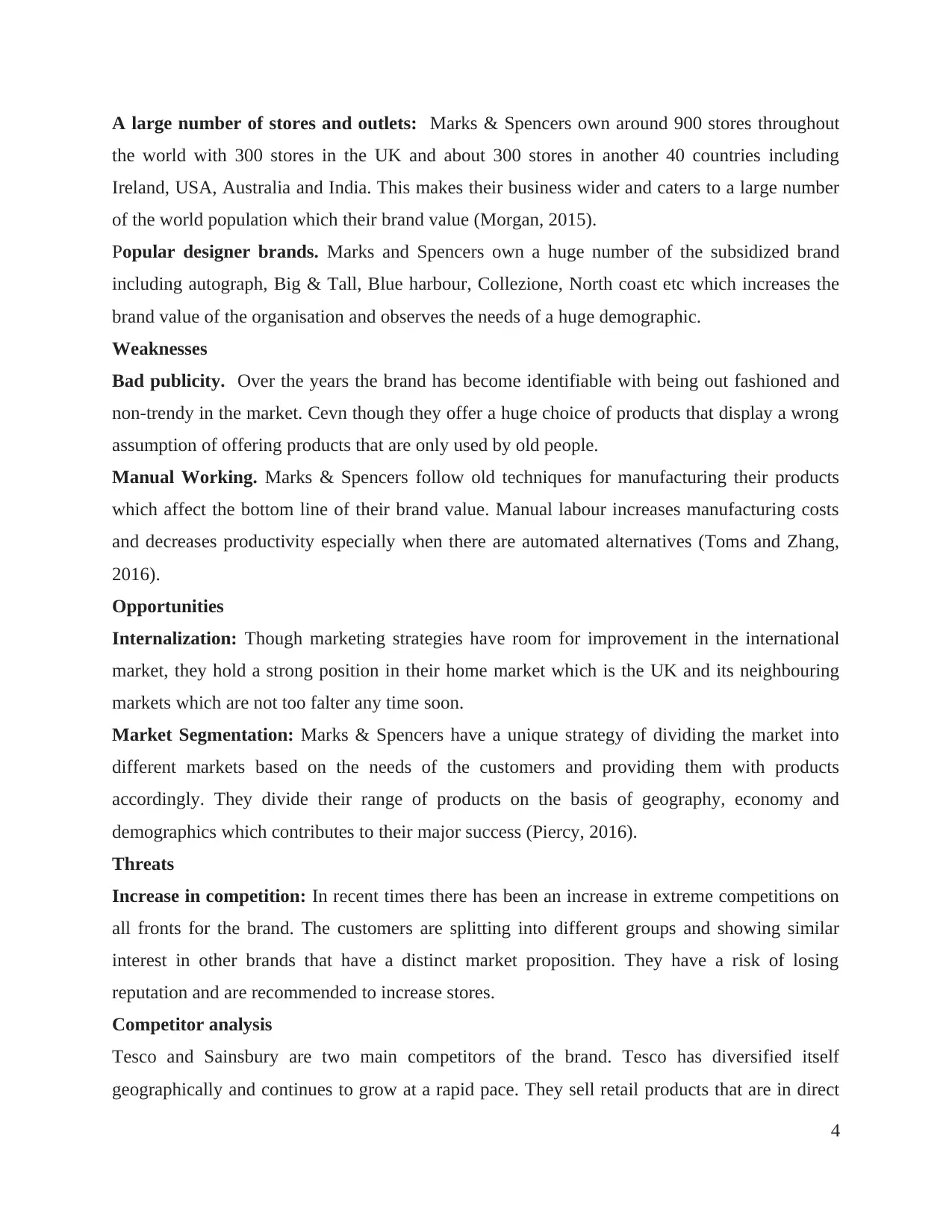
A large number of stores and outlets: Marks & Spencers own around 900 stores throughout
the world with 300 stores in the UK and about 300 stores in another 40 countries including
Ireland, USA, Australia and India. This makes their business wider and caters to a large number
of the world population which their brand value (Morgan, 2015).
Popular designer brands. Marks and Spencers own a huge number of the subsidized brand
including autograph, Big & Tall, Blue harbour, Collezione, North coast etc which increases the
brand value of the organisation and observes the needs of a huge demographic.
Weaknesses
Bad publicity. Over the years the brand has become identifiable with being out fashioned and
non-trendy in the market. Cevn though they offer a huge choice of products that display a wrong
assumption of offering products that are only used by old people.
Manual Working. Marks & Spencers follow old techniques for manufacturing their products
which affect the bottom line of their brand value. Manual labour increases manufacturing costs
and decreases productivity especially when there are automated alternatives (Toms and Zhang,
2016).
Opportunities
Internalization: Though marketing strategies have room for improvement in the international
market, they hold a strong position in their home market which is the UK and its neighbouring
markets which are not too falter any time soon.
Market Segmentation: Marks & Spencers have a unique strategy of dividing the market into
different markets based on the needs of the customers and providing them with products
accordingly. They divide their range of products on the basis of geography, economy and
demographics which contributes to their major success (Piercy, 2016).
Threats
Increase in competition: In recent times there has been an increase in extreme competitions on
all fronts for the brand. The customers are splitting into different groups and showing similar
interest in other brands that have a distinct market proposition. They have a risk of losing
reputation and are recommended to increase stores.
Competitor analysis
Tesco and Sainsbury are two main competitors of the brand. Tesco has diversified itself
geographically and continues to grow at a rapid pace. They sell retail products that are in direct
4
the world with 300 stores in the UK and about 300 stores in another 40 countries including
Ireland, USA, Australia and India. This makes their business wider and caters to a large number
of the world population which their brand value (Morgan, 2015).
Popular designer brands. Marks and Spencers own a huge number of the subsidized brand
including autograph, Big & Tall, Blue harbour, Collezione, North coast etc which increases the
brand value of the organisation and observes the needs of a huge demographic.
Weaknesses
Bad publicity. Over the years the brand has become identifiable with being out fashioned and
non-trendy in the market. Cevn though they offer a huge choice of products that display a wrong
assumption of offering products that are only used by old people.
Manual Working. Marks & Spencers follow old techniques for manufacturing their products
which affect the bottom line of their brand value. Manual labour increases manufacturing costs
and decreases productivity especially when there are automated alternatives (Toms and Zhang,
2016).
Opportunities
Internalization: Though marketing strategies have room for improvement in the international
market, they hold a strong position in their home market which is the UK and its neighbouring
markets which are not too falter any time soon.
Market Segmentation: Marks & Spencers have a unique strategy of dividing the market into
different markets based on the needs of the customers and providing them with products
accordingly. They divide their range of products on the basis of geography, economy and
demographics which contributes to their major success (Piercy, 2016).
Threats
Increase in competition: In recent times there has been an increase in extreme competitions on
all fronts for the brand. The customers are splitting into different groups and showing similar
interest in other brands that have a distinct market proposition. They have a risk of losing
reputation and are recommended to increase stores.
Competitor analysis
Tesco and Sainsbury are two main competitors of the brand. Tesco has diversified itself
geographically and continues to grow at a rapid pace. They sell retail products that are in direct
4
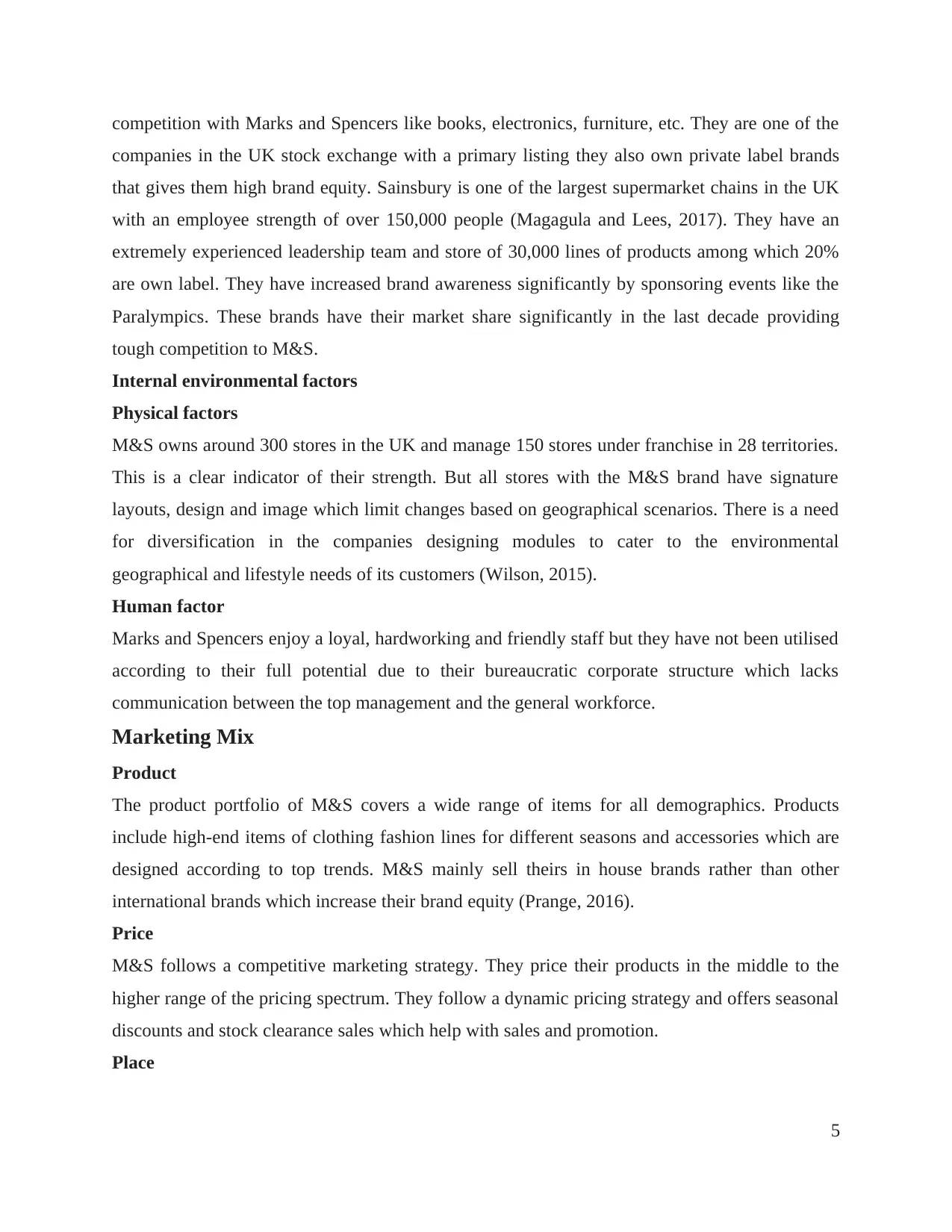
competition with Marks and Spencers like books, electronics, furniture, etc. They are one of the
companies in the UK stock exchange with a primary listing they also own private label brands
that gives them high brand equity. Sainsbury is one of the largest supermarket chains in the UK
with an employee strength of over 150,000 people (Magagula and Lees, 2017). They have an
extremely experienced leadership team and store of 30,000 lines of products among which 20%
are own label. They have increased brand awareness significantly by sponsoring events like the
Paralympics. These brands have their market share significantly in the last decade providing
tough competition to M&S.
Internal environmental factors
Physical factors
M&S owns around 300 stores in the UK and manage 150 stores under franchise in 28 territories.
This is a clear indicator of their strength. But all stores with the M&S brand have signature
layouts, design and image which limit changes based on geographical scenarios. There is a need
for diversification in the companies designing modules to cater to the environmental
geographical and lifestyle needs of its customers (Wilson, 2015).
Human factor
Marks and Spencers enjoy a loyal, hardworking and friendly staff but they have not been utilised
according to their full potential due to their bureaucratic corporate structure which lacks
communication between the top management and the general workforce.
Marketing Mix
Product
The product portfolio of M&S covers a wide range of items for all demographics. Products
include high-end items of clothing fashion lines for different seasons and accessories which are
designed according to top trends. M&S mainly sell theirs in house brands rather than other
international brands which increase their brand equity (Prange, 2016).
Price
M&S follows a competitive marketing strategy. They price their products in the middle to the
higher range of the pricing spectrum. They follow a dynamic pricing strategy and offers seasonal
discounts and stock clearance sales which help with sales and promotion.
Place
5
companies in the UK stock exchange with a primary listing they also own private label brands
that gives them high brand equity. Sainsbury is one of the largest supermarket chains in the UK
with an employee strength of over 150,000 people (Magagula and Lees, 2017). They have an
extremely experienced leadership team and store of 30,000 lines of products among which 20%
are own label. They have increased brand awareness significantly by sponsoring events like the
Paralympics. These brands have their market share significantly in the last decade providing
tough competition to M&S.
Internal environmental factors
Physical factors
M&S owns around 300 stores in the UK and manage 150 stores under franchise in 28 territories.
This is a clear indicator of their strength. But all stores with the M&S brand have signature
layouts, design and image which limit changes based on geographical scenarios. There is a need
for diversification in the companies designing modules to cater to the environmental
geographical and lifestyle needs of its customers (Wilson, 2015).
Human factor
Marks and Spencers enjoy a loyal, hardworking and friendly staff but they have not been utilised
according to their full potential due to their bureaucratic corporate structure which lacks
communication between the top management and the general workforce.
Marketing Mix
Product
The product portfolio of M&S covers a wide range of items for all demographics. Products
include high-end items of clothing fashion lines for different seasons and accessories which are
designed according to top trends. M&S mainly sell theirs in house brands rather than other
international brands which increase their brand equity (Prange, 2016).
Price
M&S follows a competitive marketing strategy. They price their products in the middle to the
higher range of the pricing spectrum. They follow a dynamic pricing strategy and offers seasonal
discounts and stock clearance sales which help with sales and promotion.
Place
5
⊘ This is a preview!⊘
Do you want full access?
Subscribe today to unlock all pages.

Trusted by 1+ million students worldwide
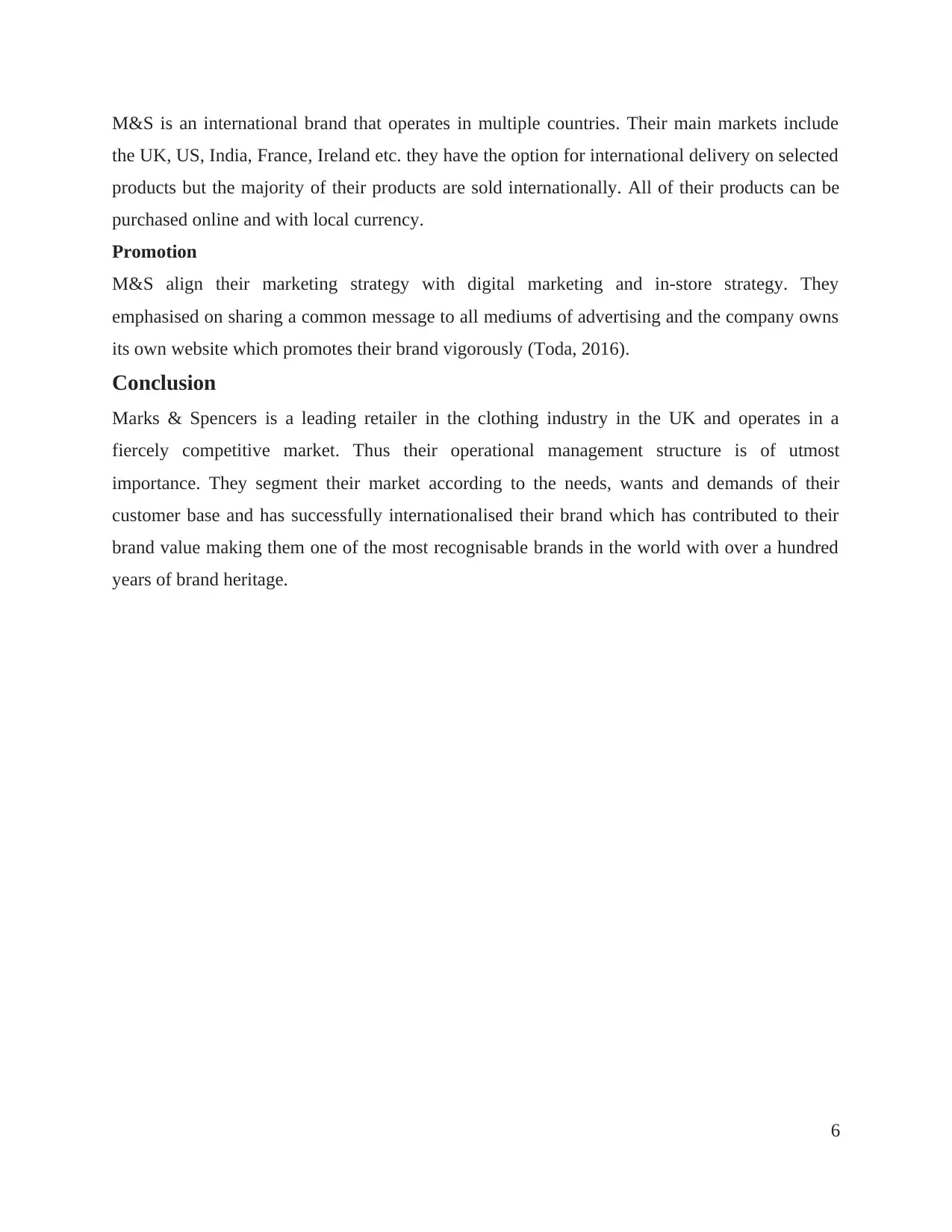
M&S is an international brand that operates in multiple countries. Their main markets include
the UK, US, India, France, Ireland etc. they have the option for international delivery on selected
products but the majority of their products are sold internationally. All of their products can be
purchased online and with local currency.
Promotion
M&S align their marketing strategy with digital marketing and in-store strategy. They
emphasised on sharing a common message to all mediums of advertising and the company owns
its own website which promotes their brand vigorously (Toda, 2016).
Conclusion
Marks & Spencers is a leading retailer in the clothing industry in the UK and operates in a
fiercely competitive market. Thus their operational management structure is of utmost
importance. They segment their market according to the needs, wants and demands of their
customer base and has successfully internationalised their brand which has contributed to their
brand value making them one of the most recognisable brands in the world with over a hundred
years of brand heritage.
6
the UK, US, India, France, Ireland etc. they have the option for international delivery on selected
products but the majority of their products are sold internationally. All of their products can be
purchased online and with local currency.
Promotion
M&S align their marketing strategy with digital marketing and in-store strategy. They
emphasised on sharing a common message to all mediums of advertising and the company owns
its own website which promotes their brand vigorously (Toda, 2016).
Conclusion
Marks & Spencers is a leading retailer in the clothing industry in the UK and operates in a
fiercely competitive market. Thus their operational management structure is of utmost
importance. They segment their market according to the needs, wants and demands of their
customer base and has successfully internationalised their brand which has contributed to their
brand value making them one of the most recognisable brands in the world with over a hundred
years of brand heritage.
6
Paraphrase This Document
Need a fresh take? Get an instant paraphrase of this document with our AI Paraphraser
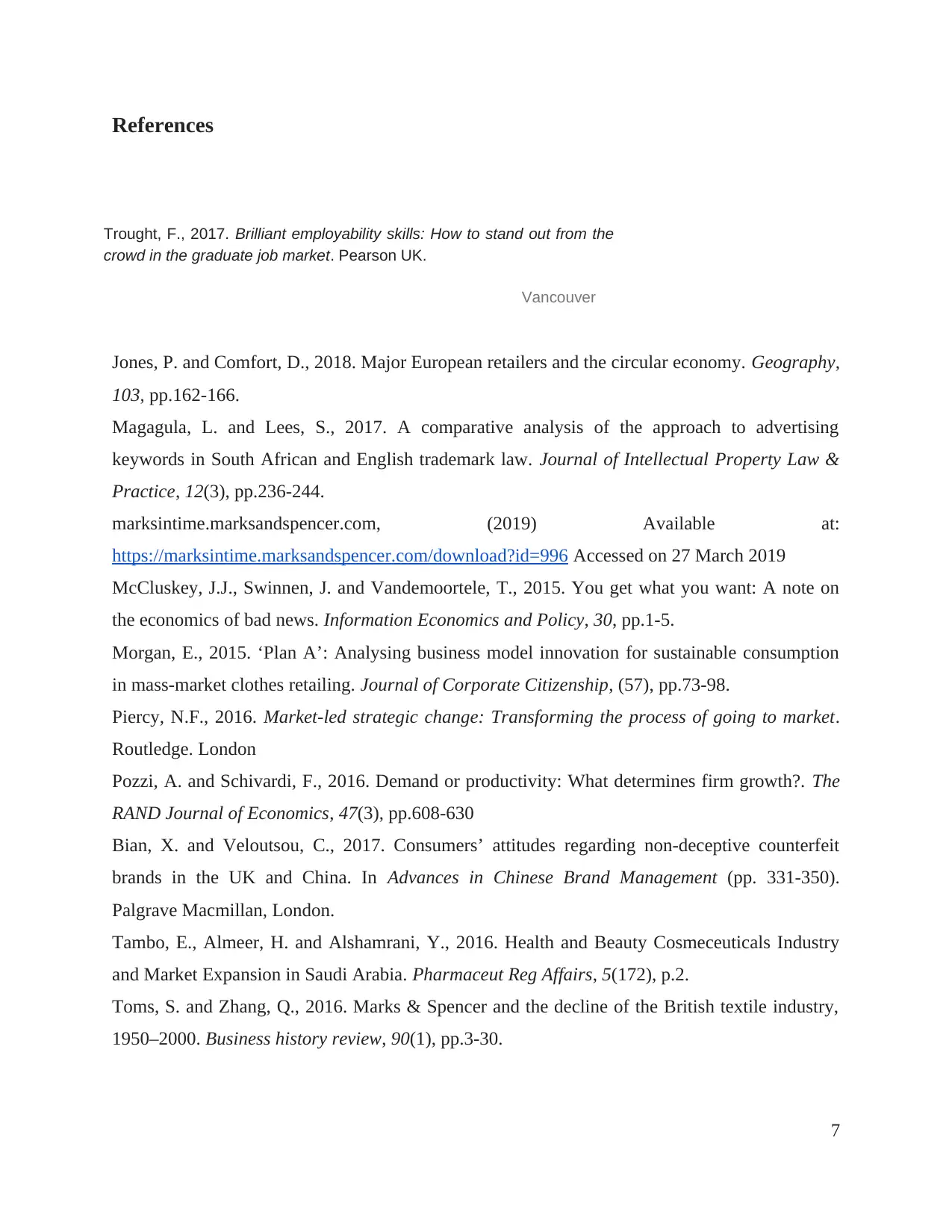
References
Trought, F., 2017. Brilliant employability skills: How to stand out from the
crowd in the graduate job market. Pearson UK.
Vancouver
Jones, P. and Comfort, D., 2018. Major European retailers and the circular economy. Geography,
103, pp.162-166.
Magagula, L. and Lees, S., 2017. A comparative analysis of the approach to advertising
keywords in South African and English trademark law. Journal of Intellectual Property Law &
Practice, 12(3), pp.236-244.
marksintime.marksandspencer.com, (2019) Available at:
https://marksintime.marksandspencer.com/download?id=996 Accessed on 27 March 2019
McCluskey, J.J., Swinnen, J. and Vandemoortele, T., 2015. You get what you want: A note on
the economics of bad news. Information Economics and Policy, 30, pp.1-5.
Morgan, E., 2015. ‘Plan A’: Analysing business model innovation for sustainable consumption
in mass-market clothes retailing. Journal of Corporate Citizenship, (57), pp.73-98.
Piercy, N.F., 2016. Market-led strategic change: Transforming the process of going to market.
Routledge. London
Pozzi, A. and Schivardi, F., 2016. Demand or productivity: What determines firm growth?. The
RAND Journal of Economics, 47(3), pp.608-630
Bian, X. and Veloutsou, C., 2017. Consumers’ attitudes regarding non-deceptive counterfeit
brands in the UK and China. In Advances in Chinese Brand Management (pp. 331-350).
Palgrave Macmillan, London.
Tambo, E., Almeer, H. and Alshamrani, Y., 2016. Health and Beauty Cosmeceuticals Industry
and Market Expansion in Saudi Arabia. Pharmaceut Reg Affairs, 5(172), p.2.
Toms, S. and Zhang, Q., 2016. Marks & Spencer and the decline of the British textile industry,
1950–2000. Business history review, 90(1), pp.3-30.
7
Trought, F., 2017. Brilliant employability skills: How to stand out from the
crowd in the graduate job market. Pearson UK.
Vancouver
Jones, P. and Comfort, D., 2018. Major European retailers and the circular economy. Geography,
103, pp.162-166.
Magagula, L. and Lees, S., 2017. A comparative analysis of the approach to advertising
keywords in South African and English trademark law. Journal of Intellectual Property Law &
Practice, 12(3), pp.236-244.
marksintime.marksandspencer.com, (2019) Available at:
https://marksintime.marksandspencer.com/download?id=996 Accessed on 27 March 2019
McCluskey, J.J., Swinnen, J. and Vandemoortele, T., 2015. You get what you want: A note on
the economics of bad news. Information Economics and Policy, 30, pp.1-5.
Morgan, E., 2015. ‘Plan A’: Analysing business model innovation for sustainable consumption
in mass-market clothes retailing. Journal of Corporate Citizenship, (57), pp.73-98.
Piercy, N.F., 2016. Market-led strategic change: Transforming the process of going to market.
Routledge. London
Pozzi, A. and Schivardi, F., 2016. Demand or productivity: What determines firm growth?. The
RAND Journal of Economics, 47(3), pp.608-630
Bian, X. and Veloutsou, C., 2017. Consumers’ attitudes regarding non-deceptive counterfeit
brands in the UK and China. In Advances in Chinese Brand Management (pp. 331-350).
Palgrave Macmillan, London.
Tambo, E., Almeer, H. and Alshamrani, Y., 2016. Health and Beauty Cosmeceuticals Industry
and Market Expansion in Saudi Arabia. Pharmaceut Reg Affairs, 5(172), p.2.
Toms, S. and Zhang, Q., 2016. Marks & Spencer and the decline of the British textile industry,
1950–2000. Business history review, 90(1), pp.3-30.
7
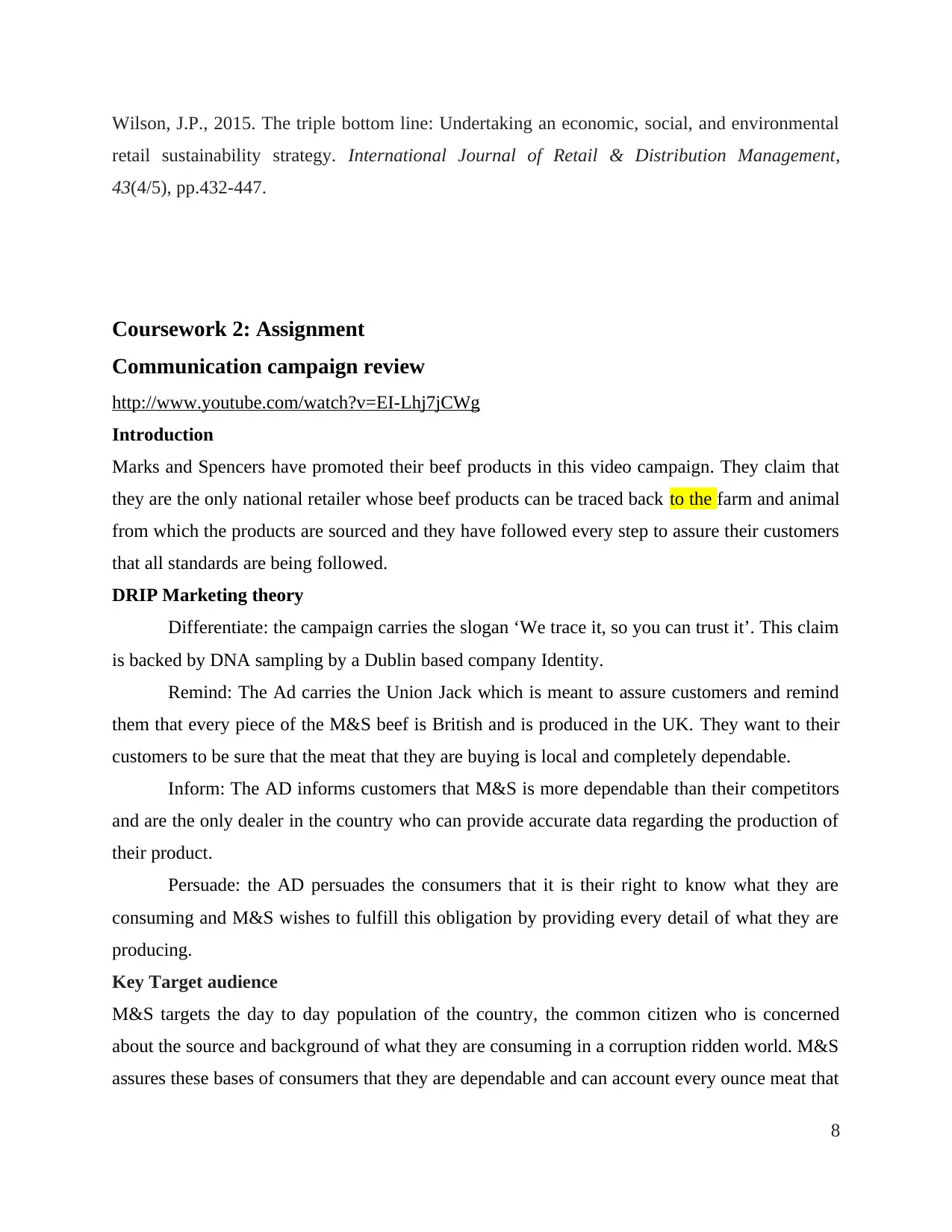
Wilson, J.P., 2015. The triple bottom line: Undertaking an economic, social, and environmental
retail sustainability strategy. International Journal of Retail & Distribution Management,
43(4/5), pp.432-447.
Coursework 2: Assignment
Communication campaign review
http://www.youtube.com/watch?v=EI-Lhj7jCWg
Introduction
Marks and Spencers have promoted their beef products in this video campaign. They claim that
they are the only national retailer whose beef products can be traced back to the farm and animal
from which the products are sourced and they have followed every step to assure their customers
that all standards are being followed.
DRIP Marketing theory
Differentiate: the campaign carries the slogan ‘We trace it, so you can trust it’. This claim
is backed by DNA sampling by a Dublin based company Identity.
Remind: The Ad carries the Union Jack which is meant to assure customers and remind
them that every piece of the M&S beef is British and is produced in the UK. They want to their
customers to be sure that the meat that they are buying is local and completely dependable.
Inform: The AD informs customers that M&S is more dependable than their competitors
and are the only dealer in the country who can provide accurate data regarding the production of
their product.
Persuade: the AD persuades the consumers that it is their right to know what they are
consuming and M&S wishes to fulfill this obligation by providing every detail of what they are
producing.
Key Target audience
M&S targets the day to day population of the country, the common citizen who is concerned
about the source and background of what they are consuming in a corruption ridden world. M&S
assures these bases of consumers that they are dependable and can account every ounce meat that
8
retail sustainability strategy. International Journal of Retail & Distribution Management,
43(4/5), pp.432-447.
Coursework 2: Assignment
Communication campaign review
http://www.youtube.com/watch?v=EI-Lhj7jCWg
Introduction
Marks and Spencers have promoted their beef products in this video campaign. They claim that
they are the only national retailer whose beef products can be traced back to the farm and animal
from which the products are sourced and they have followed every step to assure their customers
that all standards are being followed.
DRIP Marketing theory
Differentiate: the campaign carries the slogan ‘We trace it, so you can trust it’. This claim
is backed by DNA sampling by a Dublin based company Identity.
Remind: The Ad carries the Union Jack which is meant to assure customers and remind
them that every piece of the M&S beef is British and is produced in the UK. They want to their
customers to be sure that the meat that they are buying is local and completely dependable.
Inform: The AD informs customers that M&S is more dependable than their competitors
and are the only dealer in the country who can provide accurate data regarding the production of
their product.
Persuade: the AD persuades the consumers that it is their right to know what they are
consuming and M&S wishes to fulfill this obligation by providing every detail of what they are
producing.
Key Target audience
M&S targets the day to day population of the country, the common citizen who is concerned
about the source and background of what they are consuming in a corruption ridden world. M&S
assures these bases of consumers that they are dependable and can account every ounce meat that
8
⊘ This is a preview!⊘
Do you want full access?
Subscribe today to unlock all pages.

Trusted by 1+ million students worldwide
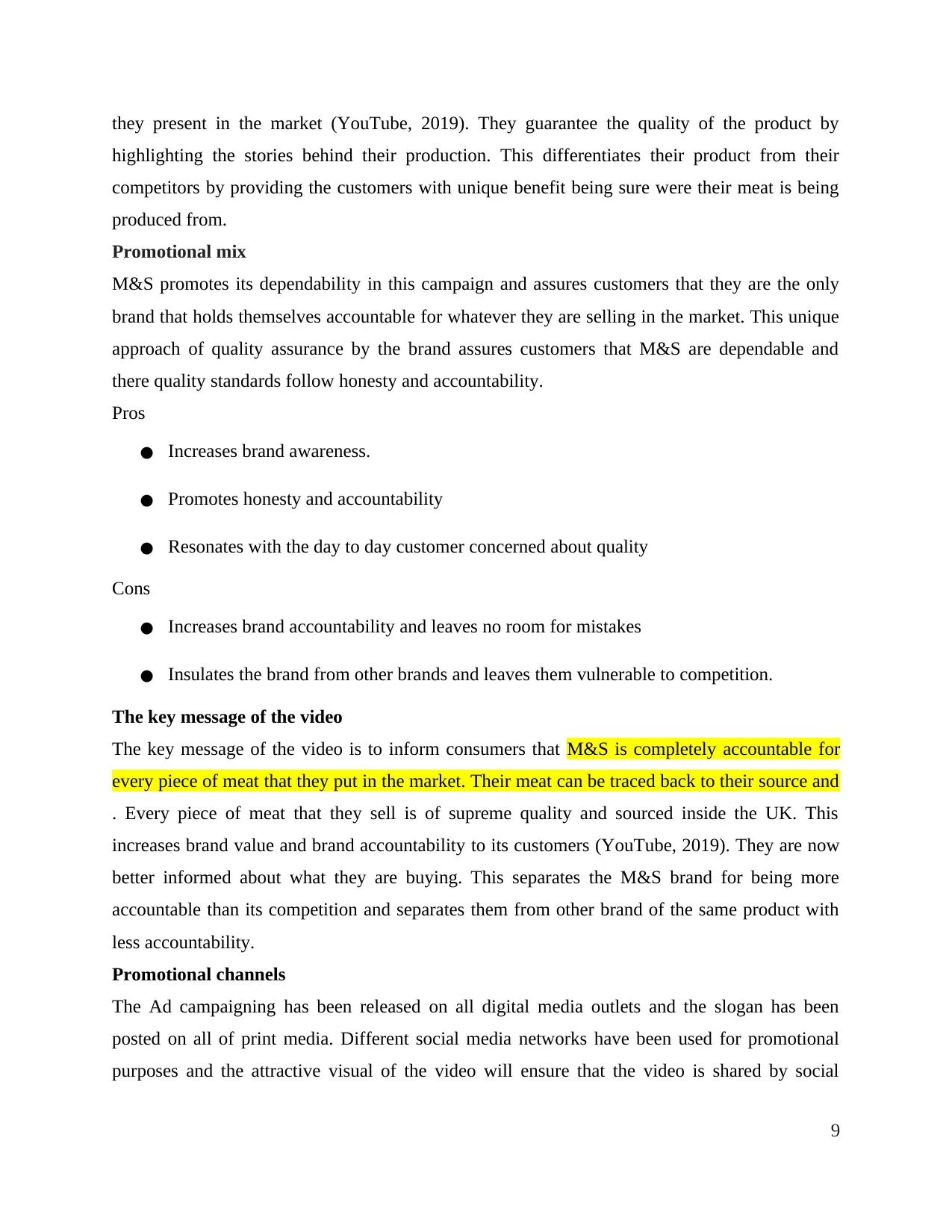
they present in the market (YouTube, 2019). They guarantee the quality of the product by
highlighting the stories behind their production. This differentiates their product from their
competitors by providing the customers with unique benefit being sure were their meat is being
produced from.
Promotional mix
M&S promotes its dependability in this campaign and assures customers that they are the only
brand that holds themselves accountable for whatever they are selling in the market. This unique
approach of quality assurance by the brand assures customers that M&S are dependable and
there quality standards follow honesty and accountability.
Pros
● Increases brand awareness.
● Promotes honesty and accountability
● Resonates with the day to day customer concerned about quality
Cons
● Increases brand accountability and leaves no room for mistakes
● Insulates the brand from other brands and leaves them vulnerable to competition.
The key message of the video
The key message of the video is to inform consumers that M&S is completely accountable for
every piece of meat that they put in the market. Their meat can be traced back to their source and
. Every piece of meat that they sell is of supreme quality and sourced inside the UK. This
increases brand value and brand accountability to its customers (YouTube, 2019). They are now
better informed about what they are buying. This separates the M&S brand for being more
accountable than its competition and separates them from other brand of the same product with
less accountability.
Promotional channels
The Ad campaigning has been released on all digital media outlets and the slogan has been
posted on all of print media. Different social media networks have been used for promotional
purposes and the attractive visual of the video will ensure that the video is shared by social
9
highlighting the stories behind their production. This differentiates their product from their
competitors by providing the customers with unique benefit being sure were their meat is being
produced from.
Promotional mix
M&S promotes its dependability in this campaign and assures customers that they are the only
brand that holds themselves accountable for whatever they are selling in the market. This unique
approach of quality assurance by the brand assures customers that M&S are dependable and
there quality standards follow honesty and accountability.
Pros
● Increases brand awareness.
● Promotes honesty and accountability
● Resonates with the day to day customer concerned about quality
Cons
● Increases brand accountability and leaves no room for mistakes
● Insulates the brand from other brands and leaves them vulnerable to competition.
The key message of the video
The key message of the video is to inform consumers that M&S is completely accountable for
every piece of meat that they put in the market. Their meat can be traced back to their source and
. Every piece of meat that they sell is of supreme quality and sourced inside the UK. This
increases brand value and brand accountability to its customers (YouTube, 2019). They are now
better informed about what they are buying. This separates the M&S brand for being more
accountable than its competition and separates them from other brand of the same product with
less accountability.
Promotional channels
The Ad campaigning has been released on all digital media outlets and the slogan has been
posted on all of print media. Different social media networks have been used for promotional
purposes and the attractive visual of the video will ensure that the video is shared by social
9
Paraphrase This Document
Need a fresh take? Get an instant paraphrase of this document with our AI Paraphraser
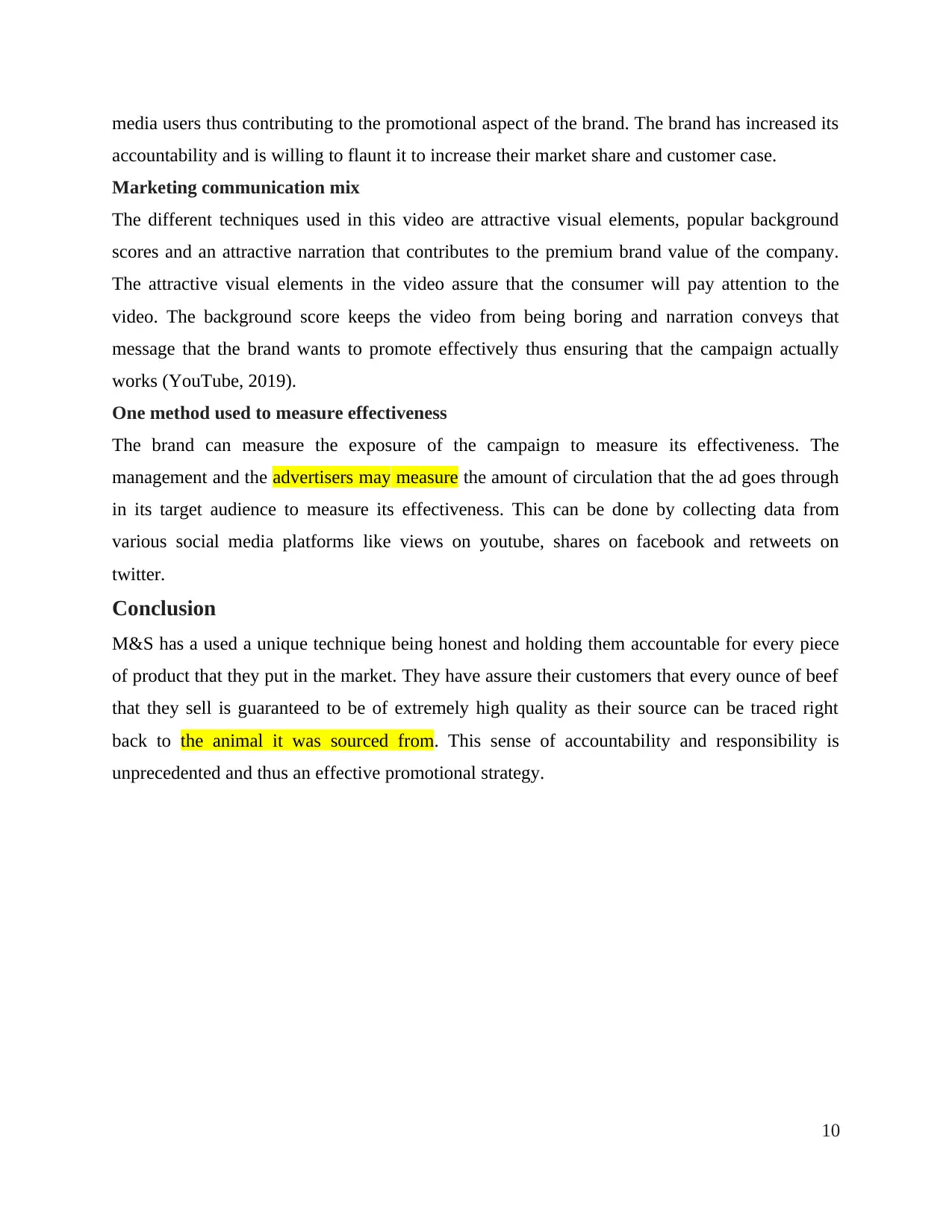
media users thus contributing to the promotional aspect of the brand. The brand has increased its
accountability and is willing to flaunt it to increase their market share and customer case.
Marketing communication mix
The different techniques used in this video are attractive visual elements, popular background
scores and an attractive narration that contributes to the premium brand value of the company.
The attractive visual elements in the video assure that the consumer will pay attention to the
video. The background score keeps the video from being boring and narration conveys that
message that the brand wants to promote effectively thus ensuring that the campaign actually
works (YouTube, 2019).
One method used to measure effectiveness
The brand can measure the exposure of the campaign to measure its effectiveness. The
management and the advertisers may measure the amount of circulation that the ad goes through
in its target audience to measure its effectiveness. This can be done by collecting data from
various social media platforms like views on youtube, shares on facebook and retweets on
twitter.
Conclusion
M&S has a used a unique technique being honest and holding them accountable for every piece
of product that they put in the market. They have assure their customers that every ounce of beef
that they sell is guaranteed to be of extremely high quality as their source can be traced right
back to the animal it was sourced from. This sense of accountability and responsibility is
unprecedented and thus an effective promotional strategy.
10
accountability and is willing to flaunt it to increase their market share and customer case.
Marketing communication mix
The different techniques used in this video are attractive visual elements, popular background
scores and an attractive narration that contributes to the premium brand value of the company.
The attractive visual elements in the video assure that the consumer will pay attention to the
video. The background score keeps the video from being boring and narration conveys that
message that the brand wants to promote effectively thus ensuring that the campaign actually
works (YouTube, 2019).
One method used to measure effectiveness
The brand can measure the exposure of the campaign to measure its effectiveness. The
management and the advertisers may measure the amount of circulation that the ad goes through
in its target audience to measure its effectiveness. This can be done by collecting data from
various social media platforms like views on youtube, shares on facebook and retweets on
twitter.
Conclusion
M&S has a used a unique technique being honest and holding them accountable for every piece
of product that they put in the market. They have assure their customers that every ounce of beef
that they sell is guaranteed to be of extremely high quality as their source can be traced right
back to the animal it was sourced from. This sense of accountability and responsibility is
unprecedented and thus an effective promotional strategy.
10
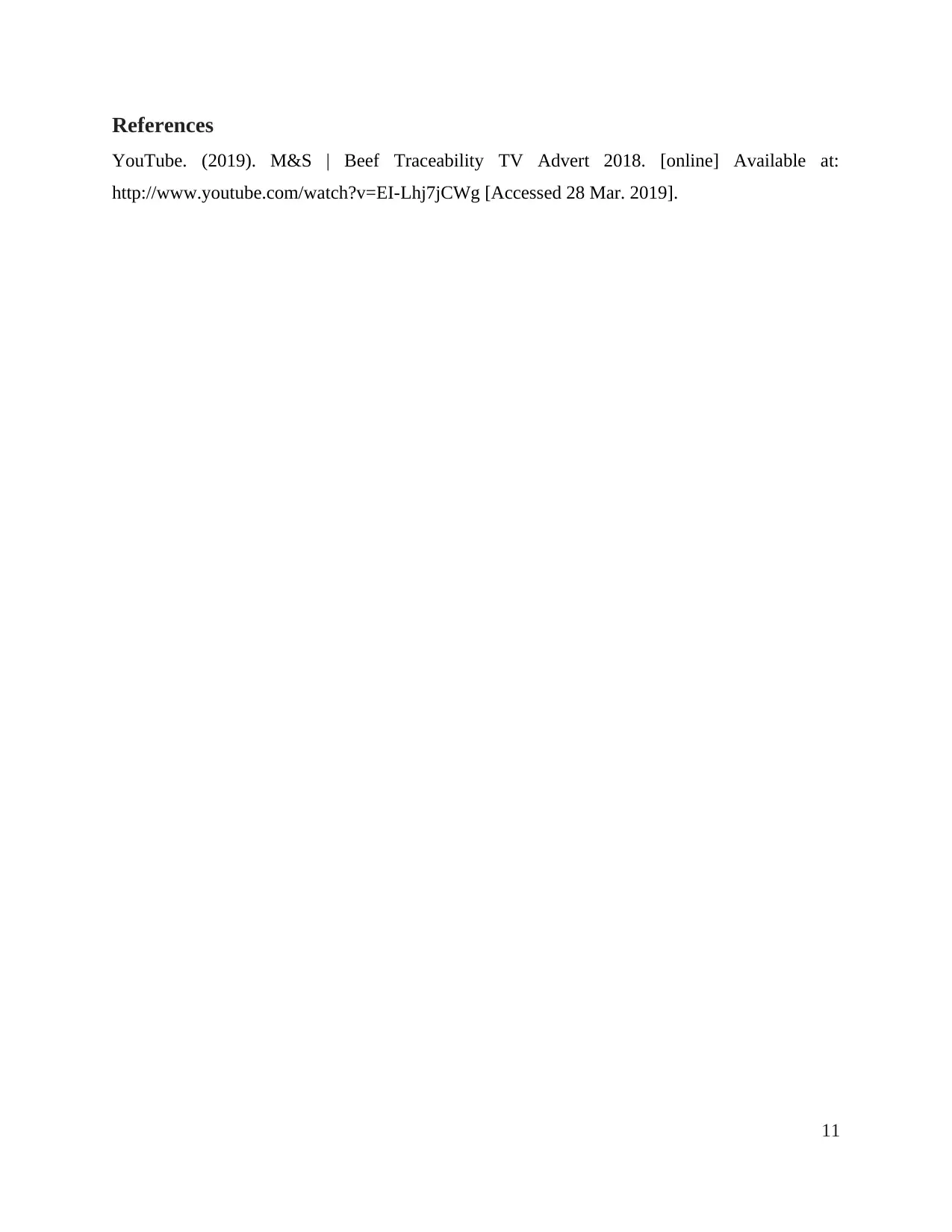
References
YouTube. (2019). M&S | Beef Traceability TV Advert 2018. [online] Available at:
http://www.youtube.com/watch?v=EI-Lhj7jCWg [Accessed 28 Mar. 2019].
11
YouTube. (2019). M&S | Beef Traceability TV Advert 2018. [online] Available at:
http://www.youtube.com/watch?v=EI-Lhj7jCWg [Accessed 28 Mar. 2019].
11
⊘ This is a preview!⊘
Do you want full access?
Subscribe today to unlock all pages.

Trusted by 1+ million students worldwide
1 out of 12
Related Documents
Your All-in-One AI-Powered Toolkit for Academic Success.
+13062052269
info@desklib.com
Available 24*7 on WhatsApp / Email
![[object Object]](/_next/static/media/star-bottom.7253800d.svg)
Unlock your academic potential
Copyright © 2020–2025 A2Z Services. All Rights Reserved. Developed and managed by ZUCOL.




